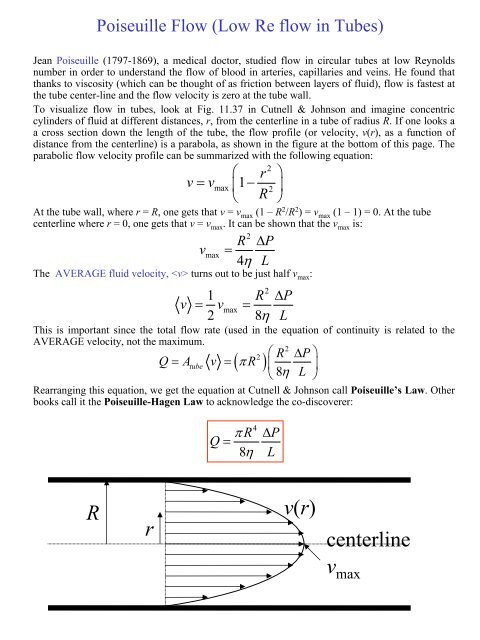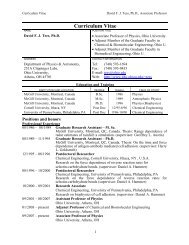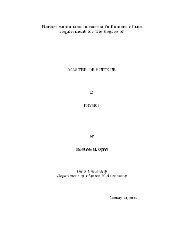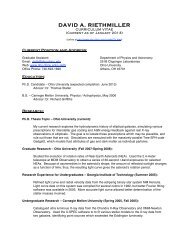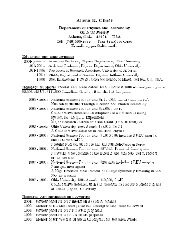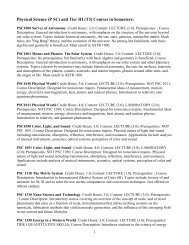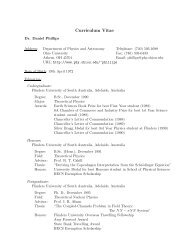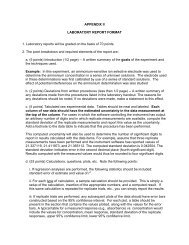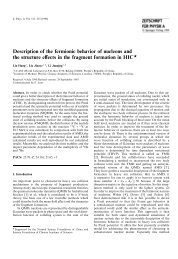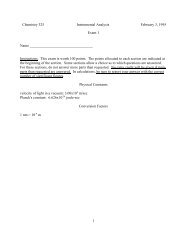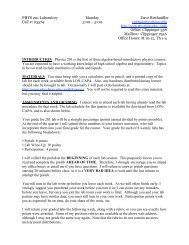Fluids in Motion Supplement I
Fluids in Motion Supplement I
Fluids in Motion Supplement I
Create successful ePaper yourself
Turn your PDF publications into a flip-book with our unique Google optimized e-Paper software.
Poiseuille Flow (Low Re flow <strong>in</strong> Tubes)<br />
Jean Poiseuille (1797-1869), a medical doctor, studied flow <strong>in</strong> circular tubes at low Reynolds<br />
number <strong>in</strong> order to understand the flow of blood <strong>in</strong> arteries, capillaries and ve<strong>in</strong>s. He found that<br />
thanks to viscosity (which can be thought of as friction between layers of fluid), flow is fastest at<br />
the tube center-l<strong>in</strong>e and the flow velocity is zero at the tube wall.<br />
To visualize flow <strong>in</strong> tubes, look at Fig. 11.37 <strong>in</strong> Cutnell & Johnson and imag<strong>in</strong>e concentric<br />
cyl<strong>in</strong>ders of fluid at different distances, r, from the centerl<strong>in</strong>e <strong>in</strong> a tube of radius R. If one looks a<br />
a cross section down the length of the tube, the flow profile (or velocity, v(r), as a function of<br />
distance from the centerl<strong>in</strong>e) is a parabola, as shown <strong>in</strong> the figure at the bottom of this page. The<br />
parabolic flow velocity profile can be summarized with the follow<strong>in</strong>g equation:<br />
⎛<br />
v= v ⎜1−<br />
r<br />
⎝ R<br />
At the tube wall, where r = R, one gets that v = v max (1 – R 2 /R 2 ) = v max (1 – 1) = 0. At the tube<br />
centerl<strong>in</strong>e where r = 0, one gets that v = v max . It can be shown that the v max is:<br />
max<br />
The AVERAGE fluid velocity, turns out to be just half v max :<br />
v<br />
v<br />
This is important s<strong>in</strong>ce the total flow rate (used <strong>in</strong> the equation of cont<strong>in</strong>uity is related to the<br />
AVERAGE velocity, not the maximum.<br />
Rearrang<strong>in</strong>g this equation, we get the equation at Cutnell & Johnson call Poiseuille’s Law. Other<br />
books call it the Poiseuille-Hagen Law to acknowledge the co-discoverer:<br />
2<br />
max 2<br />
2<br />
R ∆P<br />
=<br />
4η<br />
L<br />
⎞<br />
⎟<br />
⎠<br />
2<br />
1 R ∆P<br />
= vmax<br />
=<br />
2 8η<br />
L<br />
2<br />
2<br />
⎛ R ∆P⎞<br />
Q= Atube<br />
v = ( π R ) ⎜ ⎟<br />
⎝8η<br />
L ⎠<br />
4<br />
π R<br />
Q =<br />
8η<br />
∆P<br />
L<br />
R<br />
r<br />
v(r)<br />
centerl<strong>in</strong>e<br />
v max


